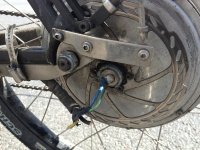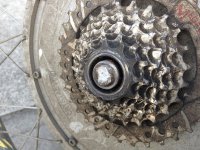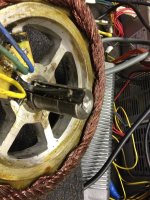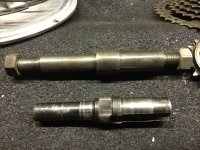NeilP
1 GW
After almost 6000 miles and one year my axle finally gave out.
First picture is taken seconds after it snapped. I was just slowly pulling away in slow traffic from a stop. I stopped before I really even moved, I probably went forward 6-12 inches. Note that just one phase wire snapped, they did not spin
Tested controller and it is OK
Very little evidence of old fracture, a slight section on the chain side , of about 1mm deep. that was not fully rusted. All the break surface was very fresh and bright




View attachment 1
Here is a test one I made many months ago as a trial. Still need to work out how to feed the wires through. Not sure if I should make anothe axle thicker still, and do a drilling rather than slot. Trouble wth that method is that then the wire exits the end of the axle and is more prone to damage. Since I am making it thicker and will need to re make torque assembly and dropouts, I suppose I could stretch the dropout area a bit, and make a second radial drilling to allow the wires out inside the dropout in a similar position to where they currently exit..
Worried about the size of hole to drill..do not want to go too big and weaken the new axle.
Think it will be 19 or 20 mm threaded portion...going big this time.
I think that if I split open the bundle of hall wires in to 5 individual cores, then the bundle of wire going into the hub can be smaller...the thinner hall wires will sit between the curves of the fatter phase wires, filling in the gaps

First picture is taken seconds after it snapped. I was just slowly pulling away in slow traffic from a stop. I stopped before I really even moved, I probably went forward 6-12 inches. Note that just one phase wire snapped, they did not spin
Tested controller and it is OK
Very little evidence of old fracture, a slight section on the chain side , of about 1mm deep. that was not fully rusted. All the break surface was very fresh and bright




View attachment 1
Here is a test one I made many months ago as a trial. Still need to work out how to feed the wires through. Not sure if I should make anothe axle thicker still, and do a drilling rather than slot. Trouble wth that method is that then the wire exits the end of the axle and is more prone to damage. Since I am making it thicker and will need to re make torque assembly and dropouts, I suppose I could stretch the dropout area a bit, and make a second radial drilling to allow the wires out inside the dropout in a similar position to where they currently exit..
Worried about the size of hole to drill..do not want to go too big and weaken the new axle.
Think it will be 19 or 20 mm threaded portion...going big this time.
I think that if I split open the bundle of hall wires in to 5 individual cores, then the bundle of wire going into the hub can be smaller...the thinner hall wires will sit between the curves of the fatter phase wires, filling in the gaps


